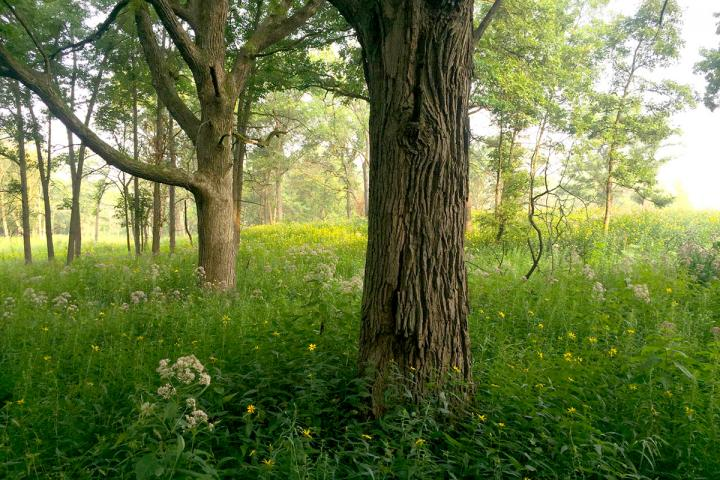Oct 30 2020
Located in the Somme Prairie Grove forest preserve in Cook County, Illinois, the Vestal Grove appears nothing like the buckthorn-choked and scrubby tangle that challenged restoration ecologists 37 years ago.
 Woodland sunflower and purple joe-pye weed grow under mature bur oak trees. Image Credit: Stephen Packard.
Woodland sunflower and purple joe-pye weed grow under mature bur oak trees. Image Credit: Stephen Packard.
Because of the efforts taken by a dedicated group that stressed on rooting up invasive plants and intermittently culling deer, as well as burning and seeding native plants, the forest once again looks like its old self, reported the researchers in the PLOS ONE journal.
Each spring, wild hyacinths, and shooting stars blossom at the bottom of mature oak trees. Appalachian brown butterflies as well as other native insects, reptiles, salamanders, and birds have come back to reclaim the territory.
The biodiversity of native plants is similar to the area’s best remnant woodlands that were not as decomposed by lack of fire or overgrazing of deer.
The researchers stated that the level of success realized in this 7-acre woodland is rare in restoration ecology. A majority of such efforts are hindered by restricted financial resources, time, expertise, and workforce. The focus of several plant restoration interventions is only on one method—like burning or brush removal to destroy invasive plants—and fail to deal with other factors that can weaken their efforts.
The researchers stated, “Even very expensive vegetation restoration projects fail to meet their conservation goals more often than not. In addition, long-term studies of management impacts are rare.”
We feel like we don’t have a minute to spare from our stewardship, so it’s hard to take time to collect data. But monitoring the ecosystem is essential for understanding the impacts of our management.
Karen Glennemeier, Study Co-Author and Ecologist, Habitat Research LLC
Greg Spyreas stated, “Once we destroy a natural area, it has proved disturbingly difficult and expensive to bring it back. This study shows you how to do it.”
Spyreas, who is the study’s co-author and a research scientist from the Illinois Natural History Survey, studies plant ecology and botany.
Collaboration was key to this success. The Cook County Forest Preserve District, which owns the land, assembled a team of staff, contractors, volunteers and a variety of research and conservation organizations.
Stephen Packard, Study Co-Author, University of Illinois at Urbana-Champaign
Packard is also a restoration ecologist and land steward of Somme Prairie Grove.
The group thinned native tree density to provide the oaks an opportunity to reproduce, slashed and incinerated a dense thicket of buckthorn trees, harvested seeds from native plants, and then spread those seeds in autumn for several years.
Scores of “citizen-science” volunteers headed the most comprehensive work while hundreds of recreational conservationists took part in the effort every year.
Packard stated, “Staff, contractors, and volunteers all helped burn the woods, on average, once every two years.”
While the volunteers hand-weeded intrusive garlic mustard, they did not bother with a majority of other weeds. The thinning of ground vegetation and trees enabled more sunlight to enter the forest floor and supported the restoration of natural woodland wildflowers and grasses.
We initially feared that alien species might be impossible to control over large areas. Instead, with regular controlled burns and reseeding of diverse species, most of the nonnative species dropped out by themselves. They couldn’t compete against the natural richness that we had thought of as so fragile.
Stephen Packard, Study Co-Author, University of Illinois at Urbana-Champaign
The team employed many measures of ecosystem health to evaluate the restoration quality, a majority of which reflected positive changes over a period of time. One of the metrics called the cover-weighted Floristic Quality Index was extremely responsive to alterations in ecological health.
The restoration work started in 1983; however, it was stopped from September 1996 to July 2003 because of a political dispute over the management of the property. The FQI revealed a steady enhancement in the biodiversity and health of the woods until the hiatus when the property started to return to its degraded state.
Packard added, “The effects were immediate. Years of work on the site could be seen slipping back into nonnative species dominance, and diversity and native plant community health crashed rapidly.”
When the restoration work restarted in 2003, the recovery started again. Biodiversity as well as the conservation quality of the surviving flora enhanced, exceeding earlier levels.
According to Packard, “Today, many people love to stroll through these restored woodlands, enchanted by their diversity and beauty. Because of what we’ve learned from this and similar experiments, much larger areas are now being restored more quickly and at less expense.”
“The opportunity to walk around these woods give you a sense of what Illinois once looked and felt like. That, to me, is priceless,” Spyreas concluded.
Journal Reference:
Glennemeier, K., et al. (2020) Dramatic long-term restoration of an oak woodland due to multiple, sustained management treatments. PLOS ONE. doi.org/10.1371/journal.pone.0241061.